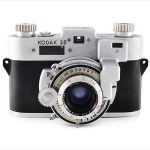Kodak 35 RF Specifications
| Manufacturer: | Eastman Kodak Company |
| Origin: | USA |
| Made in: | Rochester, NY, USA |
| Introduced: | 1940 |
| Type: | Rangefinder |
| Format: | 135 Film |
| Dimensions: | 12.8 x 8.7 x 7.7 cm |
Kodak 35 RF Overview
The Kodak 35 RF was rushed to production in Kodak’s attempt to catch up with Argus who, at the time, were having great success with their C series of consumer-friendly rangefinder cameras. Unfortunately, their entire strategy revolved around simply taking the Kodak 35 and slapping on a rangefinder assembly. However, despite their seemingly simple and cost-effective solution, the 35 RF still cost well over twice as much as the ubiquitous Argus C3 and therefore remained eating its proverbial dust until Kodak finally stopped production in 1948.
The RF’s lens is an Anastigmat Special 50mm f/3.5 which has a minimum focus distance of four feet and is coupled to a Flash Kodamatic leaf shutter capable of speeds ranging from 1/10 to 1/200 seconds as well as time and bulb. The design of the lens and shutter assembly comes straight from Kodak’s long history of medium format folding cameras which crowds all the controls onto the front barrel and contributes to the camera’s old-fashioned, cluttered look. Situated at the 12 o’clock position on the lens barrel is the shutter speed selector, 3 o’clock is the self-timer lever, at 6 o’clock is the aperture control, 7:30 is an old style flash sync post, at 9 o’clock is the focusing wheel, and you’ll find the shutter at 10:30. On the top plate, you’ll find film rewind and advance knobs with the frame counter in between. Located on the back are the rangefinder window on the left for and the viewfinder window in the middle.
To be honest, the RF doesn’t seem to be very well thought out. The controls are pretty awkward and the fact that you have to compose and focus from different windows is pretty annoying. Maybe it was the hasty decision to simply add a rangefinder onto the original Kodak 35 (which also suffered defeat at the hands of Argus) or perhaps Kodak was just too busy during WWII making cameras for the US Army Signal Corps (which, incidentally, were also based on the 35) and hand grenades for the intelligence agency that would later become the CIA. Whatever it was, it’s no small wonder that most people weren’t willing or even able to pay $48 (nearly $800 in today’s money) for it. Fortunately for me, I paid less than $20 at a local charity shop.
Find your very own Kodak 35 RF on eBay.
McKeown, James M. and Joan C. McKeown’s Price Guide to Antique and Classic Cameras, 2001-2002. (Grantsburg, WI, USA: Centennial Photo Service, 2001), p 353.

















